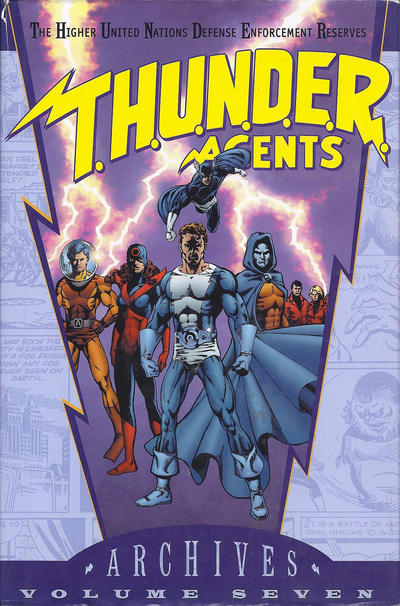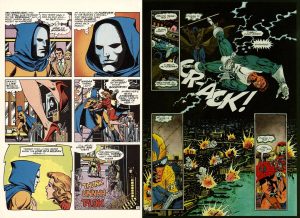Review by Frank Plowright
T.H.U.N.D.E.R. Agents was the longest-lived of various superhero comics that sprung up in the 1960s in the wake of Marvel’s success, and with the opportunity to sell directly to fans through comic shops in 1980s it was revived as a fondly remembered property. This final T.H.U.N.D.E.R. Agents Archives collects the results along with a brief 1990s revival.
The 1980s material adheres to the original formula of presenting short chapters starring individual agents, ensuring the human supporting cast have roles, and using top artistic talents. The one concession to the times is continued stories. Each of the agents has a recurring problem. Dann Thomas’ Raven adventures have the flying hero set against a very capable super spy who was once his girlfriend, and a new Menthor’s activities are complicated by the old’s personality still inhabiting the helmet, but it’s Lightning’s condition that really grabs the attention. Co-plotters Mary Bierbaum, Tom Bierbaum and Keith Giffen highlight the deficiency of him ageing every time he uses the suit enabling his super speed. It’s now taking a very visible toll resulting in an embittered hero in the darkest of the serials, including some great revelations.
That’s drawn by Giffen impersonating José Muñoz, and the jaggedness contrasts the slick superhero art of Dave Cockrum (sample spread left), Jerry Ordway and George Pérez, all on top form. In comparison Steve Ditko, the only original series artist making a return, is quirky, but old fashioned, supplying maniacally exaggerated characters. Overall this is good superhero art. Allowing for a couple of misfires, until the end there’s no repeating the 1960s mistake of the one star artist so often backed up by also-rans, and Cockrum really seems to be enjoying himself.
A major difference between the 1960s and the 1980s series is the diminishing of Dynamo. He was previously the star, but his bumbling personality and super strength didn’t resonate with the writers, and he’s only twice centre stage, both well into the collection. Undersea Agent is incorporated into the main feature, having previously been kept separate, but cuts a faintly ludicrous figure when operating on land.
The 28 pages of the 1990s reboot ignores the 1980s continuity, and really doesn’t start well, poorly written by George Carigone and Tom Thornton, featuring clichés, great wads of expository dialogue, and unconvincingly bickering agents. Once the action starts, though, things run more smoothly, and updating the series to the post-Cold War era offers new, never really explored possibilities. By then, though, the story’s almost over, meaning Paul Gulacy’s art is what remains in the memory. His technological update is attuned to the era, and his characters resonate.
Anyone who’s enjoyed the earlier Archives editions will probably enjoy this even if no ongoing plots are resolved. These are respectful continuations taking the times into account, and overall the art is of a higher quality than the original run, although no-one quite matches Wally Wood. This is the only Archives volume not subsequently issued in paperback as T.H.U.N.D.E.R. Agents Classics.

